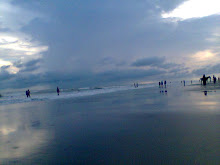
Coastal Zone Management coastal zone is a geographically delineated area which is distinctly characterized by the aggregation of interacting coastal environments and corresponding natural and man-made structural systems. Its management is essentially a 'production function' that combines inputs to produce desired outputs. The coastal zone of Bangladesh lies within the tropical zone between 21-23° N and 89-93° E. The coast of Bangladesh is about 700 km long and can be broadly divided into three regions: the deltaic eastern region (Pacific type), the deltaic central region, and the stable deltaic western region (Atlantic type). It is characterized by a vast network of rivers (24,000 km in length) covering an area of 9380 km2, a large number of islands between channels, a submarine canyon (Swatch of no Ground), the funnel shaped part of the northern bay of bengal, huge amount of sediment transportation (annually about 2.4 x 109 m tons), low relief (1.2-4.5 m above mean sea level) and horrendous tropical cyclones.
The coastal zone of Bangladesh is rich in natural resources offering many tangible and intangible benefits to the nation. The mangroves (around 570,000 ha with spectacular wildlife and wide biodiversity), fisheries (> 80% of total marine catch with 28 species of shrimps and 187 species of fish), shrimp culture activities (around 11,500 ha of the coastal area), tourism (Cox's Bazar with 145 km long beach offers attractive place for sea, sand and sun), shipping and inland navigations, ship breaking, oil and gas exploration, etc are some examples of these benefits. There are strong interaction between components of the natural systems (ecotones and gradients), between users and ecosystems; and between various users. Nevertheless, its natural resources face multiple and critical problems including non-sustainable resource uses and natural calamities, set within a human context of wide-spread poverty.
There is a lack of integration of environmental considerations in planning resulting in the absence for a truly integrated coastal zone management (ICZM). Untrammeled privatization of coastal land has posed problems for the environment. Excessive fishing and overexploitation of coastal resources, water quality deterioration, mangrove destruction for shrimp pond excavation, lack of public awareness and rampant rural poverty, institutional and legal limitations, cyclones, etc. are some of the major problems which need to be addressed on a priority basis.
[Apurba Krishna Deb]
The coastal zone of Bangladesh is rich in natural resources offering many tangible and intangible benefits to the nation. The mangroves (around 570,000 ha with spectacular wildlife and wide biodiversity), fisheries (> 80% of total marine catch with 28 species of shrimps and 187 species of fish), shrimp culture activities (around 11,500 ha of the coastal area), tourism (Cox's Bazar with 145 km long beach offers attractive place for sea, sand and sun), shipping and inland navigations, ship breaking, oil and gas exploration, etc are some examples of these benefits. There are strong interaction between components of the natural systems (ecotones and gradients), between users and ecosystems; and between various users. Nevertheless, its natural resources face multiple and critical problems including non-sustainable resource uses and natural calamities, set within a human context of wide-spread poverty.
There is a lack of integration of environmental considerations in planning resulting in the absence for a truly integrated coastal zone management (ICZM). Untrammeled privatization of coastal land has posed problems for the environment. Excessive fishing and overexploitation of coastal resources, water quality deterioration, mangrove destruction for shrimp pond excavation, lack of public awareness and rampant rural poverty, institutional and legal limitations, cyclones, etc. are some of the major problems which need to be addressed on a priority basis.
[Apurba Krishna Deb]

No comments:
Post a Comment